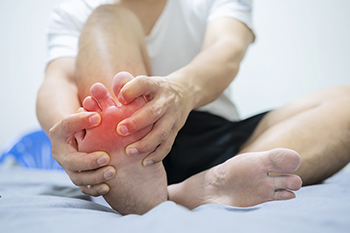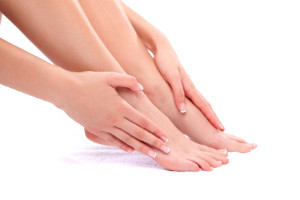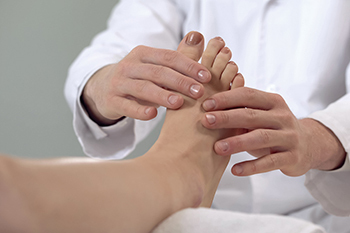Items filtered by date: October 2022
Can Arthritis Cause Ankle Pain?

There are several reasons why people have ankle pain, and one of them may be arthritis. Arthritis can be a debilitating condition that can cause severe ankle pain and discomfort, and it may be difficult to move the foot. The ankles may become swollen and stiff, and wearing shoes could become challenging. The most common form of arthritis is osteoarthritis, and this may cause wear and tear on the ankle joints. The condition known as lupus can cause a considerable amount of swelling in the ankles and may even turn them blue from becoming cold. One of the first things that is noticeable with reactive arthritis can be an inflamed Achilles tendon, which is in the back of the lower leg. If you have ankle pain for any reason, it is strongly suggested that you seek the counsel of a podiatrist who can determine what the cause is as well as offer you the correct treatment options.
Ankle pain can have many different causes and the pain may potentially be serious. If you have ankle pain, consult with one of our podiatrists from In Motion Foot and Ankle. Our doctors will assess your condition and provide you with quality foot and ankle treatment.
Ankle pain is any condition that causes pain in the ankle. Due to the fact that the ankle consists of tendons, muscles, bones, and ligaments, ankle pain can come from a number of different conditions.
Causes
The most common causes of ankle pain include:
- Types of arthritis (rheumatoid, osteoarthritis, and gout)
- Ankle sprains
- Broken ankles
- Achilles tendinitis
- Achilles tendon rupture
- Stress fractures
- Tarsal tunnel syndrome
- Plantar fasciitis
Symptoms
Symptoms of ankle injury vary based upon the condition. Pain may include general pain and discomfort, swelling, aching, redness, bruising, burning or stabbing sensations, and/or loss of sensation.
Diagnosis
Due to the wide variety of potential causes of ankle pain, podiatrists will utilize a number of different methods to properly diagnose ankle pain. This can include asking for personal and family medical histories and of any recent injuries. Further diagnosis may include sensation tests, a physical examination, and potentially x-rays or other imaging tests.
Treatment
Just as the range of causes varies widely, so do treatments. Some more common treatments are rest, ice packs, keeping pressure off the foot, orthotics and braces, medication for inflammation and pain, and surgery.
If you have any questions, please feel free to contact our offices located in Cypress and Houston, TX . We offer the newest diagnostic and treatment technologies for all your foot care needs.
Do Your Child's Feet Hurt?
Gout and the Possible Damage It Can Do

The foot condition known as gout can cause permanent damage to the tendons and joints if prompt medical attention is not sought. It is considered to be a chronic disease, in addition to being a form of arthritis. The big toe is often affected and can be painful and uncomfortable. Gout is caused by an excess of uric acid in the bloodstream and can form crystals that lodge in the joints of the big toe. This condition can develop due to genetics or from eating foods that have high levels of purines. These can include shellfish, red meat, alcohol, and drinks that are made with large amounts of sugar. Some patients have said they experience pain that is so intense it can be impossible to walk up the steps. Gout attacks may be reduced by implementing healthy lifestyle habits into daily living routines. These can consist of losing weight if applicable, exercising regularly, and drinking plenty of water. If you are afflicted with gout, it is strongly advised that you are under the care of a podiatrist who can help you to manage this condition.
Gout is a foot condition that requires certain treatment and care. If you are seeking treatment, contact one of our podiatrists from In Motion Foot and Ankle. Our doctors will treat your foot and ankle needs.
What Is Gout?
Gout is a type of arthritis caused by a buildup of uric acid in the bloodstream. It often develops in the foot, especially the big toe area, although it can manifest in other parts of the body as well. Gout can make walking and standing very painful and is especially common in diabetics and the obese.
People typically get gout because of a poor diet. Genetic predisposition is also a factor. The children of parents who have had gout frequently have a chance of developing it themselves.
Gout can easily be identified by redness and inflammation of the big toe and the surrounding areas of the foot. Other symptoms include extreme fatigue, joint pain, and running high fevers. Sometimes corticosteroid drugs can be prescribed to treat gout, but the best way to combat this disease is to get more exercise and eat a better diet.
If you have any questions please feel free to contact our offices located in Cypress and Houston, TX . We offer the newest diagnostic and treatment technologies for all your foot and ankle needs.
Several Reasons Why Stress Fractures Can Occur

Many people who develop stress fractures often continue to run through the pain that this foot condition can cause. It is a hairline fracture and may be more prevalent among people who have osteoporosis. The foot bones absorb the stress of the body, and this can easily occur if proper warmups and cool-downs are not performed. Symptoms that are generally associated with stress fractures include bruising, swelling, and tenderness in addition to difficulty in completing daily activities. Some factors can contribute to incurring a stress fracture. These can consist of having previous fractures, a lack of vitamin D, or running and jumping on uneven surfaces. An MRI is often needed to properly diagnose a stress fracture and an X-ray may follow. If you feel that you have developed this type of fracture, please consult with a podiatrist who can guide you toward the correct treatment techniques, which often begin with resting and elevating the affected foot.
Stress fractures occur when there is a tiny crack within a bone. To learn more, contact one of our podiatrists from In Motion Foot and Ankle. Our doctors can provide the care you need to keep you pain free and on your feet.
How Are They Caused?
Stress fractures are the result of repetitive force being placed on the bone. Since the lower leg and feet often carry most of the body’s weight, stress fractures are likely to occur in these areas. If you rush into a new exercise, you are more likely to develop a stress fracture since you are starting too much, too soon. Pain resulting from stress fractures may go unnoticed at first, however it may start to worsen over time.
Risk Factors
- Gender – They are more commonly found in women compared to men.
- Foot Problems – People with unusual arches in their feet are more likely to develop stress fractures.
- Certain Sports – Dancers, gymnasts, tennis players, runners, and basketball players are more likely to develop stress fractures.
- Lack of Nutrients – A lack of vitamin D and calcium may weaken the bones and make you more prone to stress fractures
- Weak Bones – Osteoporosis can weaken the bones therefore resulting in stress fractures
Stress fractures do not always heal properly, so it is important that you seek help from a podiatrist if you suspect you may have one. Ignoring your stress fracture may cause it to worsen, and you may develop chronic pain as well as additional fractures.
If you have any questions, please feel free to contact our offices located in Cypress and Houston, TX . We offer the newest diagnostic and treatment technologies for all your foot care needs.
How Children’s Feet Grow

Children’s feet are not just smaller than adult feet. They are shaped differently, and will change as they grow. During the first year of life, children’s feet are soft and supple and have ample fat pads on the soles. The arch of the foot begins to develop when a child starts to walk. The muscles become stronger as the feet grow in length and width. Before children begin to walk, their feet do not need to be covered except for warmth and hygiene. In fact, footwear that is too tight can interfere with the growth and development of their feet. Even when a child starts to walk, shoes are not needed indoors. Walking barefoot can help their feet grow normally, develop muscle tone, strength, and toe grasping action. While outside, a child’s feet should be protected by lightweight, flexible footwear. Shoes for young children should provide a degree of foot cushioning, stability, and foot flexibility. It is wise to check your child’s feet frequently to make sure their footwear is the correct size which may help to prevent foot issues from arising. If you are unsure of how to take care of your child’s feet or have questions about choosing appropriate footwear, consult a podiatrist who can help you.
The health of a child’s feet is vital to their overall well-being. If you have any questions regarding foot health, contact one of our podiatrists of In Motion Foot and Ankle. Our doctors can provide the care you need to keep you pain-free and on your feet.
Tips for Keeping Children's Feet Healthy
- Make sure their shoes fit properly
- Look for any signs of in-toeing or out-toeing
- Check to see if they have Clubfoot (condition that affects your child’s foot and ankle, twisting the heel and toes inward) which is one of the most common nonmajor birth defects.
- Lightly cover your baby’s feet (Tight covers may keep your baby from moving their feet freely, and could prevent normal development)
- Allow your toddler to go shoeless (Shoes can be restricting for a young child’s foot)
- Cut toenails straight across to avoid ingrown toenails
- Keep your child’s foot clean and dry
- Cover cuts and scrapes. Wash any scratches with soap and water and cover them with a bandage until they’ve healed.
If you have any questions, please feel free to contact our offices located in Cypress and Houston, TX . We offer the newest diagnostic and treatment technologies for all your foot care needs.

